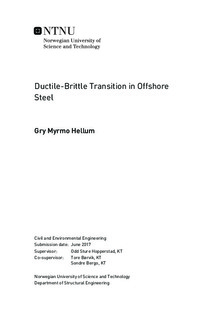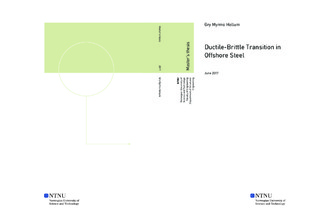| dc.description.abstract | The main objective of this thesis was to investigate experimentally and numerically the main effects and interaction effects of temperature, strain rate and stress triaxiality on an offshore X65 steel.
During preliminary simulations smooth test specimens, and specimens with different round and sharp notches, were modelled using Abaqus/Standard and Abaqus/Explicit. The models were implemented with Johnson-Cook material model, and material parameters from a material expected to have similar values as the X65 steel of this thesis. Tension tests were run at quasi-static and dynamic simulations. The stress triaxiality and stress intensification factor R were found, and used to decide which specimens to use in the experimental work.
Further, a MATLAB model implemented with the Johnson-Cook material model, the Cockcroft-Latham failure criterion and the Ritchie-Knott-Rice brittle fracture criterion was made. Here the stress triaxiality, strain rate and maximum stress intensification were varied to see how this affected the ductile to brittle transition temperature.
Tension tests were performed experimentally to study the behaviour of the steel. Smooth specimens, specimens with round notches of radii 2.0 mm (R2) and 0.8 mm (R0.8) and sharp-notched specimens were used to see the effect of stress triaxiality. The effect of strain rate was studied trough quasi-static tests and dynamic tests using split-Hopkinson tension bar. Tests were run at room temperature, -30°C, -60°C and -90°C. The specimens that showed the least ductile behaviour, were studied using Scanning Electron Microscope, but none of them had fractured due to cleavage.
The Johnson-Cook material parameters were calibrated for the steel, and simulations imitating the experimental tests were performed using Abaqus/Standard and Abaqus/Explicit. The stress and strain of the experimental and numerical results were compared. It turned out that the model was able to produce the same results as in the experiments for the smooth specimen and R2, but it overestimated the stress level for R0.8 and the V-notch.
At last the graphs with stress triaxiality, Cockcroft-Latham failure criterion and Ritchie-Knott-Rice fracture criterion were made and compared with the preliminary simulations.
The material turned out to have a higher yield strength and a higher ductility than the material from the preliminary work. The results showed that it obtained a less ductile behaviour for low temperatures, high strain rates and high values of stress triaxiality. A combination of the factors seemed to lead to interaction effects, giving even lower ductility. Although the material showed a less ductile behaviour with lower fracture strains, cleavage did not occur. Further studies are needed to find the maximum stress intensification, and to find the ductile to brittle transition. | en |

